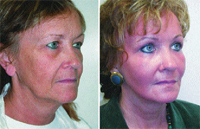Dallas - Full-face
CO2 laser resurfacing in conjunction with a
facelift not only can be performed safely, but can achieve
maximum efficient facial rejuvenation, according to cosmetic
surgeon Joseph Niamtu, M.D., who specializes in oral
maxillofacial and cosmetic facial surgery.

Dr.
Niamtu
|
He said this is accomplished by
understanding vascular anatomy, preserving critical flap
perforators, and using caution when lasering.
Dr. Niamtu, who has worked
with the combined procedures for more than five years,
presented his experiences on 21 consecutive procedures along
with a literature review at the annual meeting of the American
Society for Laser Medicine and Surgery, held here.
Dr. Niamtu said the advent
of laser technology led to a major paradigm shift in the
cosmetic surgery field. Before 1990, chemical peeling and
dermabrasion were accepted treatments for facial wrinkling.
Although both had positive treatment results, both had
significant limitations. Neither offered precise control or
predictable penetration.
Mainstay technique was
limited
Rhytidectomy had its
weaknesses, as well. Although it is the mainstay of facial
rejuvenation for the past century, it failed to improve
significant facial rhytides, especially in the area of the
central oval of the face, Dr. Niamtu said. "Facelift alone
cannot produce the required skin and collagen changes
necessary for cutaneous rejuvenation."
So began an evolution of
combining facelifts with other facial rejuvenation procedures.
"Early attempts to combine
face peeling with facelifts were disappointing and fraught
with complications," Dr. Niamtu said. The peel caused trauma
to the thin facelift flap, leading to tissue necrosis with
significant scarring.

Laser
with facelift. Also endoscopic brow and forehead lift
with four quadrant blepharoplasty. (Photos courtesy Dr.
Joseph Niamtu)
|
When lasers entered the picture,
cosmetic surgeons were hesitant to use them in conjunction
with a facelift, having experiencing the failed combination of
face peeling and facelifts. But because doctors could predict
and control lateral tissue damage, lasers offered the ability
to dramatically improve superficial and deep facial rhytides
using ultra-pulsed laser technology.
"Surgeons took baby steps
at lasering over facelift flaps," he said.
First laser treatments
flawed
The first laser resurfacing
was limited to the periorbital or perioral areas. However,
this presented unacceptable tissue demarcations; the central
oval was treated up to - but not including - the facelift
flap. (Roberts, TL. Aesth Plast Surg 1998).
As more cosmetic surgeons
gained confidence in lasers and incorporated them into facial
rejuvenation, different techniques evolved, most with
favorable results. Some surgeons only resurfaced over deep
plane flaps, and others resurfaced superficial flaps but with
low fluence, low density settings, and defocused or angled
beams.
"There were some reports of
tissue necrosis, which further muddied the water of safe and
effective treatment with combined laser resurfacing over
facelift flaps," Dr. Niamtu said. "Most studies did not
produce the horrific flap loss [that was] once feared," he
said.
Dr. Niamtu said multiple
studies have demonstrated that facelift flaps do receive an
adequate blood supply if the pedicle and major perforators are
preserved, thus supporting the idea of combined facial
rejuvenation procedures.
One study (Whetzel TP,
Mathes SJ. Plast Reconst Surg 1992) showed that all four
carotid arteries and 11 pairs of perforation arteries supply
the pedicle area in the central face, which nourishes the
dermal plexus of the facelift flap. Dye injections showed the
superficial musculoaponeurotic plane (SMAS) has little effect
on the amount of vascularity reaching the dermal plexus.
The researchers concluded
that blood supply is not increased by a thicker flap or by
preservation of perforators in the lateral aspect of the face
outside the pedicle area.
Simultaneous procedures
safe
Another study (Roberts, TL,
Pozner JN, Ritter E. Aest Plast Surg 2000) found
simultaneous rhytidectomy with lateral SMASectomy and lasering
to be safe when the dissection is terminated 3 cm lateral to
nasolabial folds to protect the vital vascular pedicle of the
face. More aggressive dissection could jeopardize the critical
perforators and decrease flap viability, especially with
concomitant resurfacing, he said. The SMASectomy technique
does not require extensive SMAS undermining, which assists in
vascular preservation.
A third study (Koch BB,
Perkins SW. Arch Facial Plast Surg 2002) found no
greater incidence of tissue slough with concomitant facelift
and laser resurfacing than with facelift alone. The incidence
of flap necrosis with either technique fell in the range of 1
percent to 3 percent.